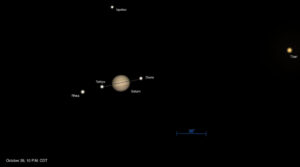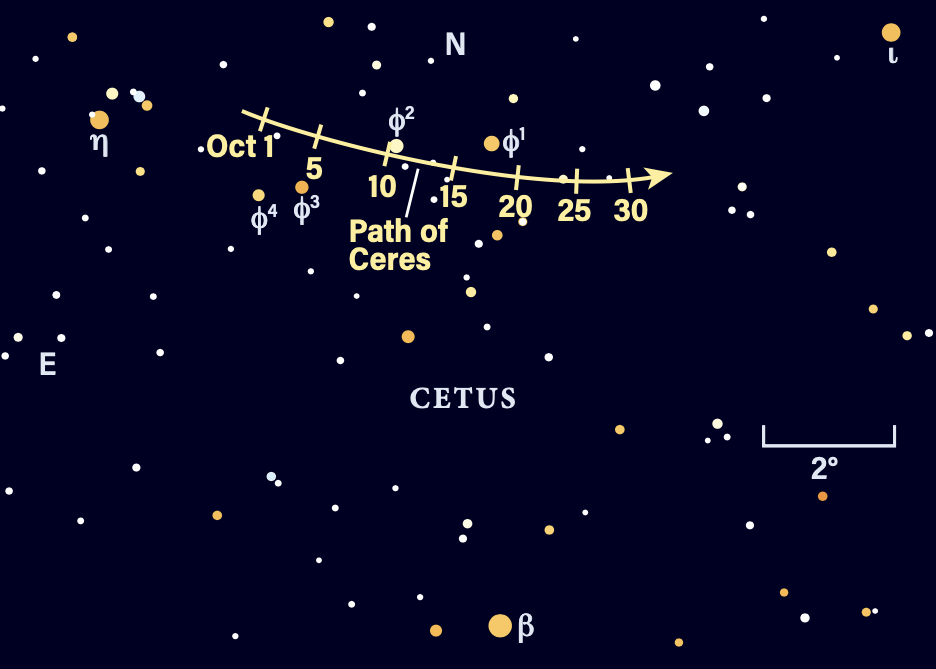Special to CosmicTribune.com, October 26, 2025
Excerpts from weekly Astronomy.com report.
Sunday, October 26
Saturn’s moon Iapetus reaches inferior conjunction tonight, sitting 1.3′ due north of Saturn and glowing at roughly 11th magnitude. This oft-elusive moon is easier to find when it is close to its parent planet, so give it a try tonight.
 Magnitude 0.7 Saturn is highest around 10 P.M. local daylight time, when it is the brightest point of light in the southern sky, hanging below the Circlet of Pisces and to the far upper left of Fomalhaut in Piscis Austrinus. Through a telescope, its rings stretch 43” wide, while its disk is 19” across.
Magnitude 0.7 Saturn is highest around 10 P.M. local daylight time, when it is the brightest point of light in the southern sky, hanging below the Circlet of Pisces and to the far upper left of Fomalhaut in Piscis Austrinus. Through a telescope, its rings stretch 43” wide, while its disk is 19” across.
At 10 P.M. CDT, Saturn’s largest and brightest moon, Titan, lies far to the planet’s west. Much closer to the western edge of the rings is smaller, 10th-magnitude Dione. Just above the rings’ eastern tip is similarly bright Tethys, with Rhea farther to the east. And north of the planet is Iapetus. Note that while the positions of Dione, Tethys, and Rhea will change throughout the night, Titan and Iapetus should remain relatively stationary for all observers.
Sunrise: 7:23 A.M.
Sunset: 6:04 P.M.
Moonrise: 12:29 P.M.
Moonset: 9:10 P.M.
Moon Phase: Waxing crescent (26%)
Monday, October 27
Jupiter passes 7° south of Pollux in Gemini at 11 A.M. EDT. You can catch the pair late this evening, visible by midnight local daylight time in the east and rising higher into the early-morning hours. Jupiter can’t be missed, glowing at magnitude –2.2 to the lower right of Castor and Pollux, the Twins’ heads.
Pollux is the lower and more golden of the pair — it’s also slightly brighter, shining at magnitude 1.2. Castor above it appears more blue-white and is magnitude 1.6. Castor is a famous double star, visible as two points of light through a telescope. One component is 2nd magnitude, while the other is a fainter 3rd magnitude.
Aim your telescope at Jupiter and East Coast observers can catch a disappearing act as Io, off to the planet’s west, disappears just after 12:10 A.M. EDT on the 28th, winking out as it passes into Jupiter’s long, dark shadow. Io will reappear from occultation about 3:45 A.M. EDT (now the 28th across the U.S.), when it pops into view off the northeastern limb.
Sunrise: 7:24 A.M.
Sunset: 6:03 P.M.
Moonrise: 1:16 P.M.
Moonset: 10:09 P.M.
Moon Phase: Waxing crescent (35%)
 Ceres spends all month within a short distance of several bright stars, aiding in its identification. Credit: Astronomy: Roen Kelly
Ceres spends all month within a short distance of several bright stars, aiding in its identification. Credit: Astronomy: Roen KellyTuesday, October 28
Tonight is an excellent opportunity to watch dwarf planet 1 Ceres move relative to the background stars of Cetus the Whale. A bonus: You can do so even if all you have is binoculars!
Ceres is now 8th magnitude, within range of binoculars and small scopes. By 9 P.M. local daylight time, it is 30° high in the southeast, located 7° above 2nd-magnitude Diphda (also called Deneb Kaitos and cataloged as Beta [β] Ceti) and about 2° west of magnitude 4.8 Phi1 (φ1) Ceti.
Ceres is passing particularly close to a similarly bright field star — it is the southernmost light of the two. Over the course of an hour or two, you can notice their relative positions change as Ceres slides from east to west south of the star. 0
Sunrise: 7:25 A.M.
Sunset: 6:02 P.M.
Moonrise: 1:56 P.M.
Moonset: 11:14 P.M.
Moon Phase: Waxing crescent (45%)
Wednesday, October 29
The Moon passes 0.1° north of Pluto at 3 A.M. EDT. The dim, distant dwarf planet is already a challenge for all but experienced observers with large scopes, and the Moon renders it pretty much invisible. If you want to hunt down Pluto, it’s best to wait for a moonless night to do so.
First Quarter Moon occurs at 12:21 P.M. EDT. It’s visible in the south in Capricornus at sunset and remains up almost all evening, setting in the half hour before midnight. The most noticeable feature on our satellite is one that is dynamic — the terminator, the dividing line between night and day, which stands halfway across the visible face of the Moon at First Quarter. Visible on the lit half of the Moon are large, dark areas — these are maria, or seas, although they were formed by lava, not water. Along the terminator to the south, you’ll spot many large, round craters. Take some time to explore the rugged terrain with a telescope. Also notice the large white feature close to the southeastern limb — this is the crater Stevinus, which is surrounded by bright rays of ejecta (material thrown up and out during the impact that created the crater). This crater has a large central peak — a common feature in impact craters — that can be seen quite well with a telescope.
Mercury reaches greatest eastern elongation (24°) at 6 P.M. EDT. The solar system’s innermost planet is low on the horizon after sunset, but bright enough that those with a clear view to the southwest may be able to catch it. Try looking half an hour after sunset, when magnitude –0.1 Mercury is 3° high. To its right is much fainter Mars (magnitude 1.4); you might need binoculars to pick it out against the brighter background. Come back tomorrow for a similar view, when we focus on this pair of planets in the evening sky.
Sunrise: 7:26 A.M.
Sunset: 6:01 P.M.
Moonrise: 2:29 P.M.
Moonset: —
Moon Phase: Waxing gibbous (55%)
Thursday, October 30
Return to the evening sky to catch Mercury now less than 9° west of Antares, the bright red heart of Scorpius the Scorpion. Half an hour after sunset, Mercury is 3.5° high, with Antares to its upper left and Mars to its right.
Mercury is the brightest light here, glowing at magnitude –0.1. Antares is next, shining at magnitude 1.1, while Mars is a tad fainter at magnitude 1.4. Mercury will be easiest to see and may pop out of the twilight without optical aid. If you have trouble spotting Mars, use binoculars or a small scope to slowly scan some 5.4° to the right (northwest) of Mercury to look for its faint, ruddy glow.
Through a telescope, Mars’ disk is tiny, just 4”, and doesn’t show surface features at this size. Mercury appears larger — 7” wide — and while no surface features are visible here either, you can see that it is not fully illuminated, but a 60-percent-lit gibbous.
The pair of planets sets by about 7 P.M. local daylight time, with Antares following shortly after.
Sunrise: 7:28 A.M.
Sunset: 6:00 P.M.
Moonrise: 2:58 P.M.
Moonset: 12:21 A.M.
Moon Phase: Waxing gibbous (65%)
 Known as both Caroline’s Rose and the Screaming Skull, open cluster NGC 7789 is visible in both the morning and evening in Cassiopeia. Credit: Bortle7/Wikimedia Commons
Known as both Caroline’s Rose and the Screaming Skull, open cluster NGC 7789 is visible in both the morning and evening in Cassiopeia. Credit: Bortle7/Wikimedia CommonsFriday, October 31
Start your Halloween off with NGC 7789, an open cluster also known as the Screaming Skull. You’ll find this star group about 20° high in the north an hour before sunrise, just below the W-shaped star pattern of Cassiopeia.
Start at Caph (Beta Cassiopeiae) and drop down a tad less than 3° toward the horizon (southwest on the sky). NGC 7789 glows at magnitude 6.6 and spans about 25’, making it a great binocular or small scope target. Discovered by Caroline Herschel, this rich young cluster of stars is often called Caroline’s Rose. But Astronomy contributor Stephen James O’Meara calls NGC 7789 the Screaming Skull because he — and many others — see a skull hidden in the patterns of stars and dark spaces instead. What do you see?
You can also catch this cluster in the evening sky. An hour after sunset, you’ll find it in the northeast instead.
So, why are we up early? It’s also to see the blazing planet Venus rising just ahead of Spica, Virgo’s alpha star. Magnitude –3.9 Venus is the brightest light in the eastern sky as it rises around 6 A.M. local daylight time. Half an hour later, roughly an hour before sunrise, 1st-magnitude Spica has just cleared the horizon. Wait another 30 minutes — half an hour before sunrise — and the pair is about 8° high, visible if your horizon is fairly clear. Spica sits just to Venus’ lower right, and will become ever-harder to see as the sky brightens.
 Venus rises ahead of the bright star Spica in Virgo in late October. It will pass due north of this star late on October 31. Credit: Stellarium.
Venus rises ahead of the bright star Spica in Virgo in late October. It will pass due north of this star late on October 31. Credit: Stellarium.Venus will pass 4° due north of Spica tonight at midnight EDT. The planet will sit a little closer to the star if you’re up tomorrow morning at the same time to catch them.
Sunrise: 7:29 A.M.
Sunset: 5:58 P.M.
Moonrise: 3:24 P.M.
Moonset: 1:31 A.M.
Moon Phase: Waxing gibbous (75%)

You must be logged in to post a comment Login